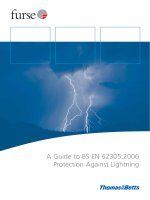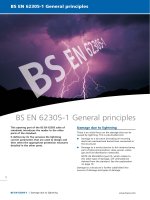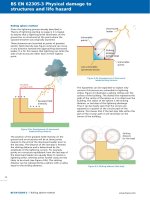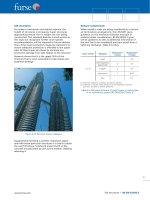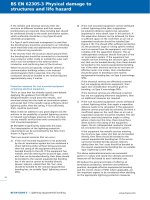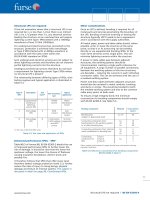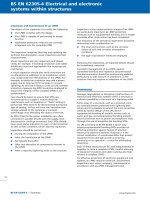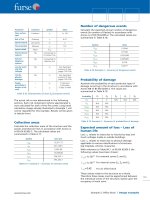Bsi bs en 00635 2 1995 (1999)
Bạn đang xem bản rút gọn của tài liệu. Xem và tải ngay bản đầy đủ của tài liệu tại đây (408.14 KB, 14 trang )
BRITISH STANDARD
BS EN
635-2:1995
Incorporating
Amendment No. 1
Plywood —
Classification by
surface appearance —
Part 2: Hardwood
The European Standard EN 635-2:1995 has the status of a
British Standard
ICS 79.060.10
BS EN 635-2:1995
Committees responsible for this
British Standard
The preparation of this British Standard was entrusted to Technical
Committee B/541, Wood based panels, upon which the following bodies were
represented:
APA/Engineered Wood Association
Association of British Plywood and Veneer Manufacturers
British Woodworking Federation
Council of the Forest Industries of British Columbia
Department of the Environment (Building Research Establishment)
Finnish Plywood International
Flat Roofing Contractors’ Advisory Board
Forestry Commission
Furniture Industry Research Association
Institution of Structural Engineers
Local Authority Organizations
Mineral Bonded Board Products Federation
National Federation of Roofing Contractors
National House-Building Council
National Panel Products Association
Royal Institute of British Architects
Structural Board Association
Timber Research and Development Association
Timber Trade Federation
Wood Panel Industries Federation
Zurich Municipal Building Guarantee
Co-opted members
This British Standard, having
been prepared under the
direction of the Sector Board for
Building and Civil Engineering,
was published under the
authority of the Standards Board
and comes into effect on
15 December 1995
© BSI 07-1999
The following BSI references
relate to the work on this
standard:
Committee reference B/541
Draft for comment 92/114811 DC
ISBN 0 580 24769 4
Amendments issued since publication
Amd. No.
Date
Comments
9124
June 1996 Indicated by a sideline in the margin
BS EN 635-2:1995
Contents
Committees responsible
National foreword
Foreword
Text of EN 635-2
List of references
© BSI 07-1999
Page
Inside front cover
ii
2
3
Inside back cover
i
BS EN 635-2:1995
National foreword
This British Standard has been prepared by Technical Committee B/541 and is
the English language version of EN 635-2:1995 Plywood — Classification by
surface appearance — Part 2: Hardwood, published by the European Committee
for Standardization (CEN). EN 635-2 was produced as a result of international
discussions in which the United Kingdom took an active part.
BS EN 635-1, BS EN 635-2 and BS EN 635-3 together supersede BS 6566-6:1985,
which will be withdrawn in accordance with CEN provisions within 6 months of
completion of the full package of standards covering plywood and related test
methods. These standards are:
EN 310
EN 313-1
EN 313-2
EN 314-1
EN 314-2
EN 315
EN 322
EN 323
EN 324-1
EN 324-2
EN 325
EN 635-1
EN 635-2
EN 635-3
EN 636-1
EN 636-2
EN 636-3
EN 1072
EN 1084
The method of classification used in BS EN 635-2 and BS EN 635-3 is similar to
that of BS 6566-6:1985. But although the appearance classes in BS EN 635-2 and
BS EN 635-3 are identified as E, I, II, III and IV, these classes do not correspond
exactly to the appearance classes E, I, II, III and IV of BS 6566-6. The BS EN 635
standards are thus not technically equivalent to BS 6566-6.
Cross-reference
Publication referred to
Corresponding British Standard
EN 635-1:1994
BS EN 635 Plywood — Classification by surface
appearance
Part 1:1995 General
NOTE EN 635-2 makes informative reference to EN 636-1, EN 636-2 and EN 636-3 which are
currently in preparation.
A British Standard does not purport to include all the necessary provisions of a
contract. Users of British Standards are responsible for their correct application.
Compliance with a British Standard does not of itself confer immunity
from legal obligations.
Summary of pages
This document comprises a front cover, an inside front cover, pages i and ii,
the EN title page, pages 2 to 8, an inside back cover and a back cover.
This standard has been updated (see copyright date) and may have had
amendments incorporated. This will be indicated in the amendment table on the
inside front cover.
ii
© BSI 07-1999
EUROPEAN STANDARD
EN 635-2
NORME EUROPÉENNE
May 1995
EUROPÄISCHE NORM
ICS 79.060.10
Descriptors: Wood board, plywood, deciduous timber, classifications, appearance, defects
English version
Plywood — Classification by surface appearance —
Part 2: Hardwood
Contreplaqué — Classification selon l’aspect
des faces —
Partie 2: Bois feuillus
Sperrholz — Klassifizierung nach dem
Aussehen der Oberfläche —
Teil 2: Laubholz
www.bzfxw.com
This European Standard was approved by CEN on 1995-04-14. CEN members
are bound to comply with the CEN/CENELEC Internal Regulations which
stipulate the conditions for giving this European Standard the status of a
national standard without any alteration.
Up-to-date lists and bibliographical references concerning such national
standards may be obtained on application to the Central Secretariat or to any
CEN member.
This European Standard exists in three official versions (English, French,
German). A version in any other language made by translation under the
responsibility of a CEN member into its own language and notified to the
Central Secretariat has the same status as the official versions.
CEN members are the national bodies of Austria, Belgium, Denmark, Finland,
France, Germany, Greece, Iceland, Ireland, Italy, Luxembourg, Netherlands,
Norway, Portugal, Spain, Sweden, Switzerland and United Kingdom.
CEN
European Committee for Standardization
Comité Européen de Normalisation
Europäisches Komitee für Normung
Central Secretariat: rue de Stassart 36, B-1050 Brussels
© 1995 All rights of reproduction and communication in any form and by any means reserved in all
countries to CEN and its members
Ref. No. EN 635-2:1995 E
EN 635-2:1995
Foreword
This European Standard has been prepared by the
Technical Committee CEN/TC 112, Wood-based
panels, of which the secretariat is held by DIN.
This standard is one of a series of standards for the
classification of plywood by surface appearance. The
other Parts of this series are listed in clause 2 and
Annex A.
This European Standard shall be given the status of
a national standard, either by publication of an
identical text or by endorsement, at the latest by
November 1995, and conflicting national standards
shall be withdrawn at the latest by November 1995.
According to the CEN/CENELEC Internal
Regulations, the following countries are bound to
implement this European Standard: Austria,
Belgium, Denmark, Finland, France, Germany,
Greece, Iceland, Ireland, Italy, Luxembourg,
Netherlands, Norway, Portugal, Spain, Sweden,
Switzerland and United Kingdom.
Contents
Foreword
1 Scope
2 Normative references
3 Classification by surface appearance
3.1 Appearance classes
3.2 Permissible characteristics and defects
Annex A (informative) Bibliography
Table 1 — Classification according to
characteristics inherent in wood
Table 2 — Classification according to
manufacturing defects
Page
2
3
3
3
3
3
7
4
6
www.bzfxw.com
2
© BSI 07-1999
EN 635-2:1995
1 Scope
3 Classification by surface appearance
This European Standard specifies the nature and
limits of characteristics inherent in wood and
manufacturing defects enabling the visual
assessment of the plywood for allocation to an
appearance class. This classification is a
contribution to assessing the finishing suitability of
plywood.
This Part of EN 635 applies to plywood, the surface
veneers of which are made from hardwood1) species.
It does not apply to overlaid panels.
3.1 Appearance classes
2 Normative references
This European Standard incorporates by dated or
undated reference, provisions from other
publications. These normative references are cited
at the appropriate places in the text and the
publications are listed hereafter. For dated
references, subsequent amendments to or revisions
of any of these publications apply to this European
Standard only when incorporated in it by
amendment or revision. For undated references the
latest edition of the publication referred to applies.
EN 635-1, Plywood — Classification by surface
appearance — Part 1: General.
Assessment of characteristics and defects for
determination of appearance class shall be carried
out in accordance with EN 635-1. Surface
classification shall be based on the permissible
characteristics and defects within each of the
appearance classes as specified in 3.2.
NOTE Guidance on selection of finishing for each appearance
class is given in ENV 635-4.
3.2 Permissible characteristics and defects
Each surface shall be individually assigned to one of
the appearance classes E, I, II, III, IV, as defined by
the permissible characteristics and defects
indicated in Table 1 and Table 2.
www.bzfxw.com
1)
In English, this means conventionally broadleaved species.
© BSI 07-1999
3
Table 1 — Classification according to characteristics inherent in wood
Categories of characteristics
Appearance class
E
3.2.1.1 Pin
Practically
absent
knotsa
3.2.1.2 Sound intergrown knots
I
3/m2 permitted
II
III
IV
Permitted
EN 635-2:1995
4
3.2.1 Classification according to characteristics inherent in wood
Permitted up to an individual diameter of:
15 mm provided their
35 mm
cumulative diameter does
not exceed 30 mm/m2
50 mm
Permitted, but see note
Such knots may have splits provided they are
very slight
3.2.1.3 Unsound or non-adhering
knots and knot holes
Permitted up to an individual diameter of:
6 mm if filled and up to a
number of 2/m2
3.2.1.4 Splits
Open
slight
5 mm if unrepaired,
40 mm
25 mm if filled and up
to a number of 3/m2
Permitted if less than:
1/10
1/3
of panel length
up to an individual width of:
3 mm
Permitted, but see note
www.bzfxw.com
1/3
5 mm
20mm
3/m
3/m
and up to a number of:
3/m
of panel width
if properly filled
Closed
Permitted
if unrepaired, or
unlimited if all filled
Permitted, but see note
© BSI 07-1999
© BSI 07-1999
Table 1 — Classification according to characteristics inherent in wood
Categories of characteristics
Appearance class
E
3.2.1.5 Abnormalities due to insects, Not permitted
marine borers and parasitic plants
I
Not permitted
II
Marks of parasitic plants not permitted. Insects
and marine borer holes permitted up to a:
diameter of 3 mm
vertically to the plane
of the panel up
to 10/m2
3.2.1.6 Inbark
Not permitted
Practically
absent
Permitted
if very slight
25 mm
Permitted, but
see note
Permitted, but
see note
Permitted
if slight
3.2.1.8 Discoloration which is not
wood destroying
Permitted if low contrast
3.2.1.9 Fungal decay, which is wood Not permitted
destroying
Not permitted
3.2.1.10 Other characteristics
To be considered under the category which they most closely resemble
Practically
absent
IV
width of 15 mm and a
length of 60 mm up
to 3/m2
Permitted up to a width of:
5 mm if properly filled
3.2.1.7 Irregularities in the
structure of the wood
III
Permitted
www.bzfxw.com
NOTE Characteristics inherent to the wood are permitted provided that they do not impair the serviceability of the panel.
a
Pin knots: sound intergrown knots of no more than 3 mm diameter.
EN 635-2:1995
5
Table 2 — Classification according to manufacturing defects
Categories of defects
Appearance class
E
3.2.2.1 Open joints
I
II
III
IV
Not permitted Not permitted Permitted up to a width of:
3 mm
5 mm
25 mm
2/m
unlimited
unfilled
unfilled
Permitted up to a
number of 2/m2
Permitted but
see note
EN 635-2:1995
6
3.2.2 Classification according to manufacturing defects
and up to a number of:
1/m
of panel width with joints
filled if more than 1 mm in
width
3.2.2.2 Overlaps
Not permitted Permitted up to a number
of 1/m2 and up to 100 mm
length
3.2.2.3 Blisters
Not permitted
3.2.2.4 Hollows, imprints and bumps
Not permitted Permitted if slight
Permitted
3.2.2.5 Roughness
Not permitted Permitted if slight
Permitted
3.2.2.6 Sanding through
Not permitted
Permitted up to an extent of:
www.bzfxw.com
1%
5 % (but see note)
of panel surface
3.2.2.7 Glue penetration
Not permitted Permitted:
if slight and occasional
3.2.2.8 Foreign particles
up to an extent of 5 % Permitted but
of the panel surface see note
Not permitted Ferrous particles not permitted
3.2.2.9 Repairs:
a) patches;
b) shims;
c) synthetic fillers.
Practically
Permitted if properly made and tightly filled up to a number of:
without defects
unlimited
3/m2
6/m2
Not permitted Not permitted Permitted within the limits specified in the
categories
unlimited
3.2.2.10 Defects at the edges of the
panel due to sanding or sawing
Practically
Permitted up to:
without defects 2 mm
5 mm
Permitted but
see note
© BSI 07-1999
from the edge
3.2.2.11 Other characteristics or defects
NOTE
To be considered under the category which they most closely resemble
Manufacturing defects are permitted provided that they do not impair the serviceability of the panel.
EN 635-2:1995
Annex A (informative)
Bibliography
EN 313-1, Plywood — Classification and terminology — Part 1: Classification.
EN 313-2, Plywood — Classification and terminology — Part 2: Terminology.
EN 635-1, Plywood — Classification by surface appearance — Part 1: General.
EN 635-2, Plywood — Classification by surface appearance — Part 2: Hardwood.
ENV 635-4, Guideline — Plywood — Classification by surface appearance — Part 4: Parameters of ability
for finishing2).
EN 636-1, Plywood — Specifications — Part 1: Requirements for plywood for use in dry conditions.
EN 636-2, Plywood — Specifications — Part 2: Requirements for plywood for use in humid conditions.
EN 636-3, Plywood Specifications — Part 3: Requirements for plywood for use in exterior conditions.
2)
At present at the draft stage.
© BSI 07-1999
7
8
blank
BS EN 635-2:1995
List of references
See national foreword.
© BSI 07-1999
BS EN
635-2:1995
BSI — British Standards Institution
BSI is the independent national body responsible for preparing
British Standards. It presents the UK view on standards in Europe and at the
international level. It is incorporated by Royal Charter.
Revisions
British Standards are updated by amendment or revision. Users of
British Standards should make sure that they possess the latest amendments or
editions.
It is the constant aim of BSI to improve the quality of our products and services.
We would be grateful if anyone finding an inaccuracy or ambiguity while using
this British Standard would inform the Secretary of the technical committee
responsible, the identity of which can be found on the inside front cover.
Tel: 020 8996 9000. Fax: 020 8996 7400.
BSI offers members an individual updating service called PLUS which ensures
that subscribers automatically receive the latest editions of standards.
Buying standards
Orders for all BSI, international and foreign standards publications should be
addressed to Customer Services. Tel: 020 8996 9001. Fax: 020 8996 7001.
In response to orders for international standards, it is BSI policy to supply the
BSI implementation of those that have been published as British Standards,
unless otherwise requested.
Information on standards
BSI provides a wide range of information on national, European and
international standards through its Library and its Technical Help to Exporters
Service. Various BSI electronic information services are also available which give
details on all its products and services. Contact the Information Centre.
Tel: 020 8996 7111. Fax: 020 8996 7048.
Subscribing members of BSI are kept up to date with standards developments
and receive substantial discounts on the purchase price of standards. For details
of these and other benefits contact Membership Administration.
Tel: 020 8996 7002. Fax: 020 8996 7001.
Copyright
Copyright subsists in all BSI publications. BSI also holds the copyright, in the
UK, of the publications of the internationalstandardization bodies. Except as
permitted under the Copyright, Designs and Patents Act 1988 no extract may be
reproduced, stored in a retrieval system or transmitted in any form or by any
means – electronic, photocopying, recording or otherwise – without prior written
permission from BSI.
This does not preclude the free use, in the course of implementing the standard,
of necessary details such as symbols, and size, type or grade designations. If these
details are to be used for any other purpose than implementation then the prior
written permission of BSI must be obtained.
BSI
389 Chiswick High Road
London
W4 4AL
If permission is granted, the terms may include royalty payments or a licensing
agreement. Details and advice can be obtained from the Copyright Manager.
Tel: 020 8996 7070.

